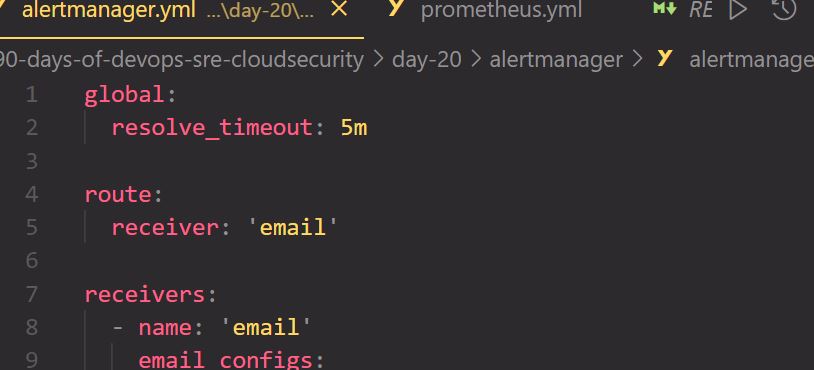Day 20 of my 90-day DevOps journey: Configuring Alerting Rules in Prometheus for Beginners and Intermediates
 Abigeal Afolabi
Abigeal Afolabi
Welcome back! Today is Day 20, and I'm thrilled to dive into a crucial topic: Prometheus alerting. We've covered Prometheus and Grafana in the past, but this is a whole new level of monitoring power. Get ready to take your system monitoring to the next level!
Imagine this: You're enjoying a relaxing evening when your phone suddenly buzzes. It's an alert from your monitoring system, warning you about a critical issue in your production environment. You spring into action, quickly diagnose the problem, and prevent a major outage. This is the power of effective alerting!
In this blog post, we'll dive into the world of Prometheus alerting, a crucial skill for anyone involved in DevOps or system administration. Whether you're a beginner just starting out or an intermediate user looking to enhance your alerting strategies, this guide will equip you with the knowledge and best practices to set up a robust and reliable alerting system.
1. The Importance of Alerting in DevOps
Imagine a world without alerts. You'd be constantly monitoring dashboards, refreshing screens, and hoping to catch issues before they escalate. This is not only inefficient but also prone to human error.
Alerting systems are essential for:
Proactive Monitoring: Alerts notify you of issues before they impact users, allowing you to take proactive steps to prevent outages or performance degradation.
Quick Response: Faster issue resolution minimizes downtime and ensures a smoother user experience.
Operational Insights: Alerts provide valuable insights into system behavior and performance trends, helping you identify bottlenecks, understand root causes, and make informed decisions.
2. Setting Up Alerting Rules in Prometheus
Prometheus uses a powerful query language called PromQL to define alerting rules. These rules evaluate metrics data to determine if a condition is met, triggering an alert if necessary. Let's break down the process:
Alerting Rules File: Alerting rules are defined in a separate YAML file, typically
alert_rules.yml. This file is usually located in the Prometheus configuration directory.Defining an Alert: Here's a simple example of an alerting rule:
groups:
- name: example
rules:
- alert: HighMemoryUsage
expr: node_memory_MemAvailable_bytes / node_memory_MemTotal_bytes * 100 < 20
for: 5m
labels:
severity: warning
annotations:
summary: "High memory usage detected"
description: "Available memory is less than 20% for the last 5 minutes."
Key Components Explained:
alert: The name of the alert.
expr: The PromQL expression that triggers the alert. This expression evaluates to true or false based on the collected metrics data.
for: The duration for which the condition must be true before triggering the alert. This helps avoid false positives due to temporary spikes in metrics.
labels: Metadata for the alert, such as severity. This allows you to categorize alerts based on their importance.
annotations: Additional information, often used for notifications. This can include a summary of the alert, a detailed description, or any relevant links.
3. Best Practices for Creating Actionable Alerts
Alerting is a powerful tool, but it can also lead to alert fatigue if not used effectively. Here are some best practices to ensure your alerts are actionable and provide real value:
Avoid Alert Fatigue: Limit the number of alerts to avoid overwhelming the team. Focus on critical alerts that require immediate attention.
Prioritize Alerts: Use labels like
severityto categorize alerts based on their importance. This helps you quickly identify the most critical issues.Actionable Alerts: Ensure every alert has a clear and actionable response. Avoid vague descriptions. What steps should the team take when they receive the alert?
4. Example Alerts for Common Scenarios
Let's explore some common alerting scenarios and how to set up alerts for them:
High CPU Usage:
- alert: HighCPUUsage
expr: 100 - (avg by(instance) (rate(node_cpu_seconds_total{mode="idle"}[5m])) * 100) > 80
for: 5m
labels:
severity: critical
annotations:
summary: "High CPU usage detected"
description: "CPU usage is above 80% for the last 5 minutes on {{ $labels.instance }}."
Disk Space Alert:
- alert: LowDiskSpace
expr: (node_filesystem_avail_bytes{mountpoint="/"} / node_filesystem_size_bytes{mountpoint="/"}) * 100 < 10
for: 10m
labels:
severity: warning
annotations:
summary: "Low disk space"
description: "Disk space is less than 10% on {{ $labels.instance }}."
5. Visual Aids and Testing
Diagrams and Screenshots: Use diagrams to illustrate the alerting workflow and screenshots for setting up rules. This helps visualize the process and makes it easier to understand.
Testing Alerts: Before deploying, test alerts to ensure they trigger correctly and notifications are sent as expected. This helps catch any errors or inconsistencies in your configuration.
6. Conclusion
Configuring alerting rules in Prometheus is a critical skill for maintaining system reliability and performance. By following best practices and setting up actionable alerts, you can ensure a well-monitored environment that responds swiftly to potential issues. Whether you're a beginner or intermediate user, this guide provides a solid foundation for mastering alerting in Prometheus. Now go forth and create a robust alerting system that keeps your systems running smoothly!
Additional Tips:
Start Small: Begin with a few critical alerts and gradually expand your alerting system as you gain experience.
Document Your Alerts: Keep a clear record of your alerting rules, including their purpose, trigger conditions, and response actions.
Monitor Your Alerts: Regularly review your alerts to ensure they are still relevant and effective. Adjust them as needed based on changes in your system or monitoring needs.
Remember: Alerting is a powerful tool, but it's essential to use it wisely. By following these best practices and staying vigilant, you can create an alerting system that helps you maintain system stability and prevent major outages.
See you on Day 21!
Subscribe to my newsletter
Read articles from Abigeal Afolabi directly inside your inbox. Subscribe to the newsletter, and don't miss out.
Written by

Abigeal Afolabi
Abigeal Afolabi
🚀 Software Engineer by day, SRE magician by night! ✨ Tech enthusiast with an insatiable curiosity for data. 📝 Harvard CS50 Undergrad igniting my passion for code. Currently delving into the MERN stack – because who doesn't love crafting seamless experiences from front to back? Join me on this exhilarating journey of embracing technology, penning insightful tech chronicles, and unraveling the mysteries of data! 🔍🔧 Let's build, let's write, let's explore – all aboard the tech express! 🚂🌟 #CodeAndCuriosity